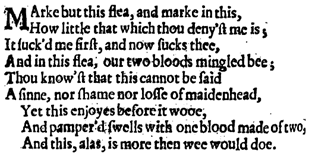The Flea (poem)
"The Flea" is an erotic metaphysical poem (first published posthumously in 1633) by John Donne (1572–1631). The exact date of its composition is unknown, but it is probable that Donne wrote this poem in the 1590s when he was a young law student at Lincoln's Inn, before he became a respected religious figure as Dean of St Paul's Cathedral.[1] The poem uses the conceit of a flea, which has sucked blood from the male speaker and his female lover, to serve as an extended metaphor for the relationship between them. The speaker tries to convince a lady to sleep with him, arguing that if their blood mingling in the flea is innocent, then sexual mingling would also be innocent. His argument hinges on the belief that bodily fluids mix during sexual intercourse.[2]
According to Laurence Perrine, this poem, along with many other of Donne's poems, solidifies his place in the literary movement, creating what is now known as Metaphysical poetry. Although the term was not found until after his death, it is still widely used and will continue to be traced back to work such as "The Flea".[3]
Criticism
Scholars have stated that Donne's work was not taboo during the 17th century due to other metaphorical references to the flea. Anthony Low wrote that Donne invented a new kind of private love that people can learn to appreciate.[4] Achsah Guibbory challenged Low, saying "The Flea" focuses on Donne's capacity for arrogance and misogyny, making his poetry crude in today's society.[5]
Guibbory further argued that the detailed descriptions of women's bodies in a sexual way give a negative reaction for today's women readers,[5] while Low stated there is an initial shock for readers, but instead attempted to look at the poem as a tool to create a new space for mutual love in lyric poetry.[4]
Tone
Fleas were everywhere throughout the renaissance, both in real life and erotic poetry. Donne's speaker enviously describes the flea's ability to suck his mistress’ skin and amalgamate his fluids with hers, which is how 17th-century society viewed sex. Many lines allude to sex, such as the way the insect “swells” with blood inline eight to suggest a man's erection.
Despite its lewdness, Donne also relies on religious imagery to woo the virgin. There are commonalities to the Holy Trinity in regard to the man, woman, and flea. The speaker attempts to make his argument respectable when he suggests the flea's action makes the couple married, despite using a half rhyme instead of a complete one as if to undermine his argument because he knows it's false.
The conclusion is full of images of death: “make thee apt to kill me”, and “self-murder” as the lady purples her finger when squashing the creature. Primarily throughout the Jacobean period —and occasionally used today— phrases about death are euphemisms for orgasm, the petit mort, or little death. Her action of killing the flea slightly changes the speaker's tone as it sparks a new rationale for his seduction: as you didn't lose your life with the flea, you won't lose much if you surrender your virginity. Donne is applauded for his ability to establish the tone of necessity, particularly in The Flea. [6]
The tone of the poem is, however, comical and the use of absurdity changes the meaning of the poem. The speakers exaggerated way of expressing their request is largely influenced by John Donne's career as a lawyer. Donne is using satire in order to ridicule the ways lawyers argue. In the end, it is revealed that the speaker's sexual conquest does not prove to be successful because of the intentional flaws Donne uses in the speaker's argument. [7]
Typography

Typography is defined as the style or appearance of printed matter in order to give a certain effect to best convey meaning in a poem. During Donne's lifetime, it was standard to use the long s, which appears more like the letter 'f'. The third line, "Me it sucks'd first, and now sucks thee," could allude to exactly what the narrator thought the flea, and he himself wished, to be doing. The written 's' closely resembled the letter 'f' presents an ambiguity in the printed version of the poem. Scholars such as Andrew Keener suggest that Donne knew of this word for fornication because one of his contemporaries, John Florio, published a dictionary in 1598 that included the word fornication, which Donne is likely to have been familiar with.[8][9][10]
Metaphysical Poetry
Donne (1572 – 1631) was the most influential metaphysical poet.[11] His personal relationship with religion and sexual relations seem to influence the majority of his work. The psychological analysis and sexual realism of his work are key to the development of poetic style. Nayeli Riano [12] believes "The Flea" gives a new outlook to metaphysical poetry combining philosophical and spiritual approach that conveys an obscene word choice.
Metaphysical poetry, the natural that too is unnatural, is seldom direct and easy to decipher; making it intellectually stimulating to read.[13] Donne's themes are explained through unusual metaphors turning the strangest idea into the depiction of the human experience.
References
| Wikisource has original text related to this article: |
- Dautch, Aviva (2017-03-30). "A close reading of 'The Flea'". The British Library. Retrieved 2019-09-13.
- Black, Joseph; Conolly, Leonard; Flint, Kate; Grundy, Isobel; Lepan, Don; Liuzza, Roy; McGann, Jerome J.; Prescott, Anne Lake; Qualls, Barry V.; Waters, Claire (2006-05-05). The Broadview Anthology of British Literature, Volume 2. ISBN 978-1-55111-610-5.
- Perrine, Laurence (1990). "Explicating Donne: "The Apparition" and "The Flea"". College Literature. 17 (1): 1–20. ISSN 0093-3139. JSTOR 25111839.
- Low, Anthony (November 1993). The Reinvention of Love by Anthony Low. Cambridge Core. doi:10.1017/CBO9780511551680. ISBN 9780521450300. Retrieved 2019-10-08.
- Guibbory, Achsah (2006). The Cambridge Companion to John Donne. Cambridge University Press.
- Dautch, Aviva. “A Close Reading of 'The Flea'.” The British Library, The British Library, 30 Mar. 2017, www.bl.uk/shakespeare/articles/a-close-reading-of-the-flea.
- Rumens, Carol. “Poem of the Week: The Flea by John Donne.” The Guardian, Guardian News and Media, 9 Dec. 2019 Poem of the week: The Flea by John Donne.
- Dautch, Aviva. “A Close Reading of 'The Flea'.” The British Library, The British Library, 30 Mar. 2017, www.bl.uk/shakespeare/articles/a-close-reading-of-the-flea.
- Keener, Andrew. “Typography and Obscenity: The Case of John Donne’s ‘The Flea’.” Vade Mecum. 13 May 2014. andrewkeener.net/2014/05/13/typography-and-obscenity-the-case-of-john-donnes-the-flea/. Retrieved 28 Feb 2020.
- Florio, John. Florio's 1598 Italian/English Dictionary, www.pbm.com/~lindahl/florio1598/160.html. Retrieved 28 February 2020.
- Poets, Academy of American. "A Brief Guide to Metaphysical Poets | Academy of American Poets". poets.org. Retrieved 2019-10-08.
- Riano, Nayeli (2019-02-15). "A Foray Into Metaphysical Poetry With John Donne". The Imaginative Conservative. Retrieved 2019-10-08.
- Smith, W. Bradford (1934). "What Is Metaphysical Poetry?". The Sewanee Review. 42 (3): 261–272. ISSN 0037-3052. JSTOR 27535002.
